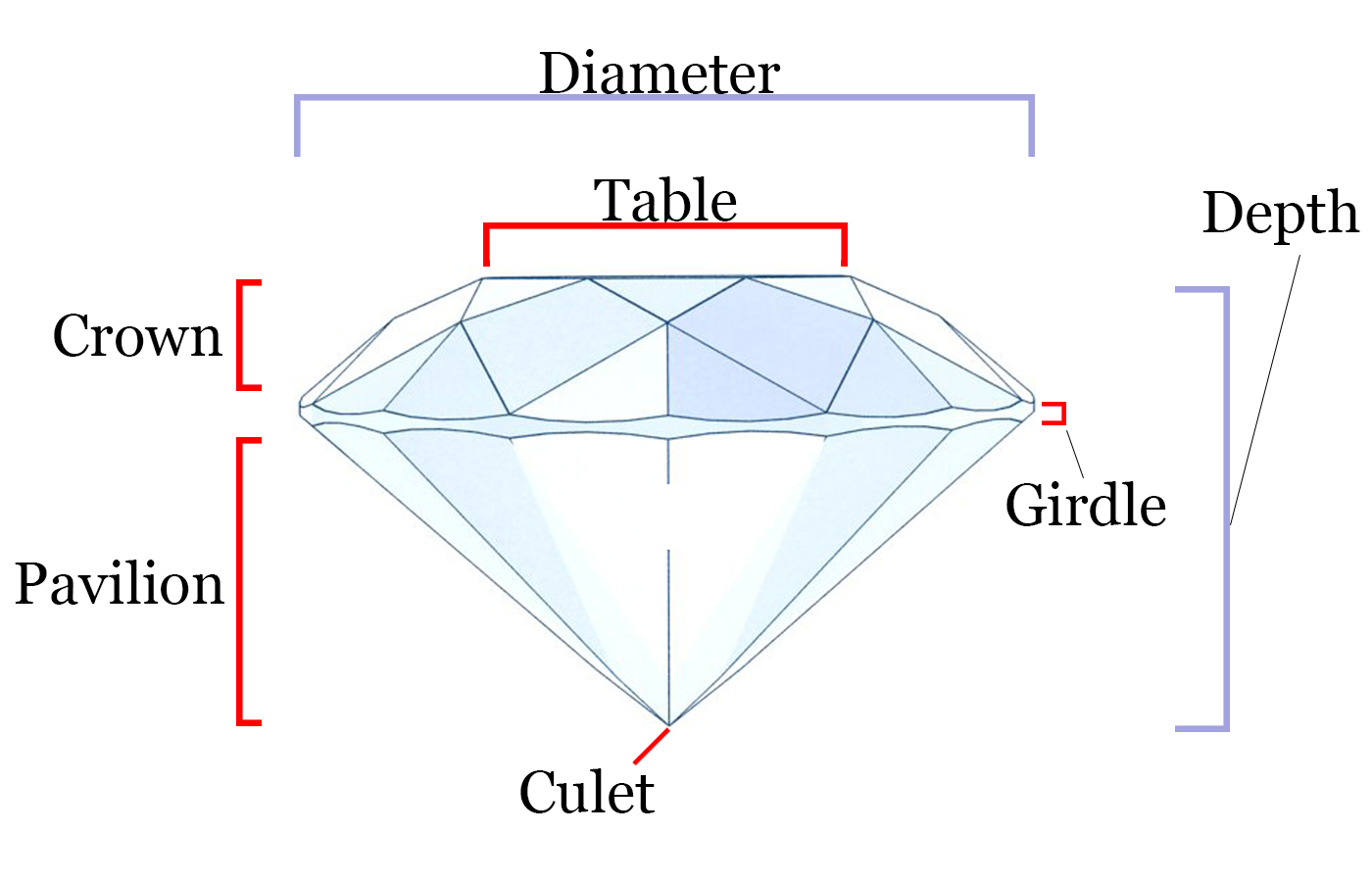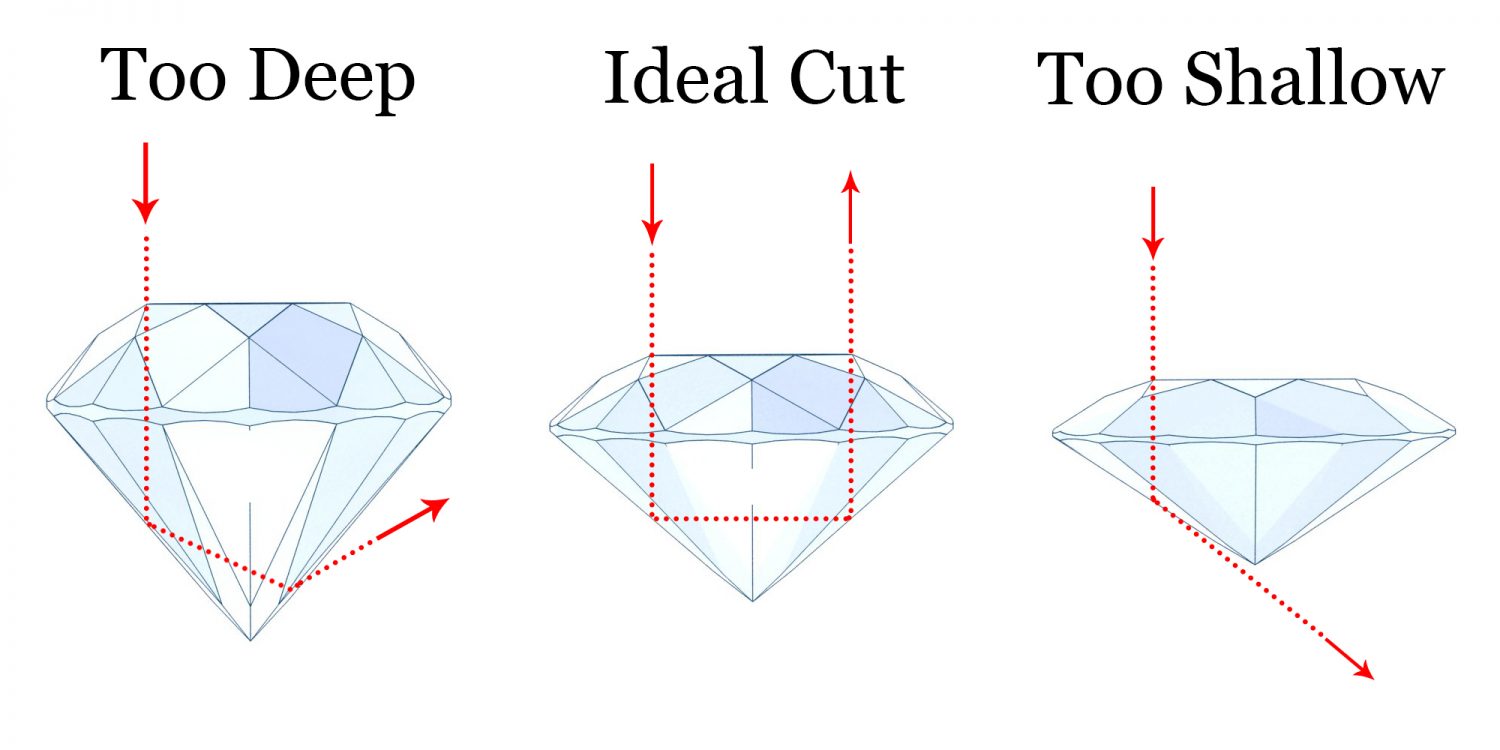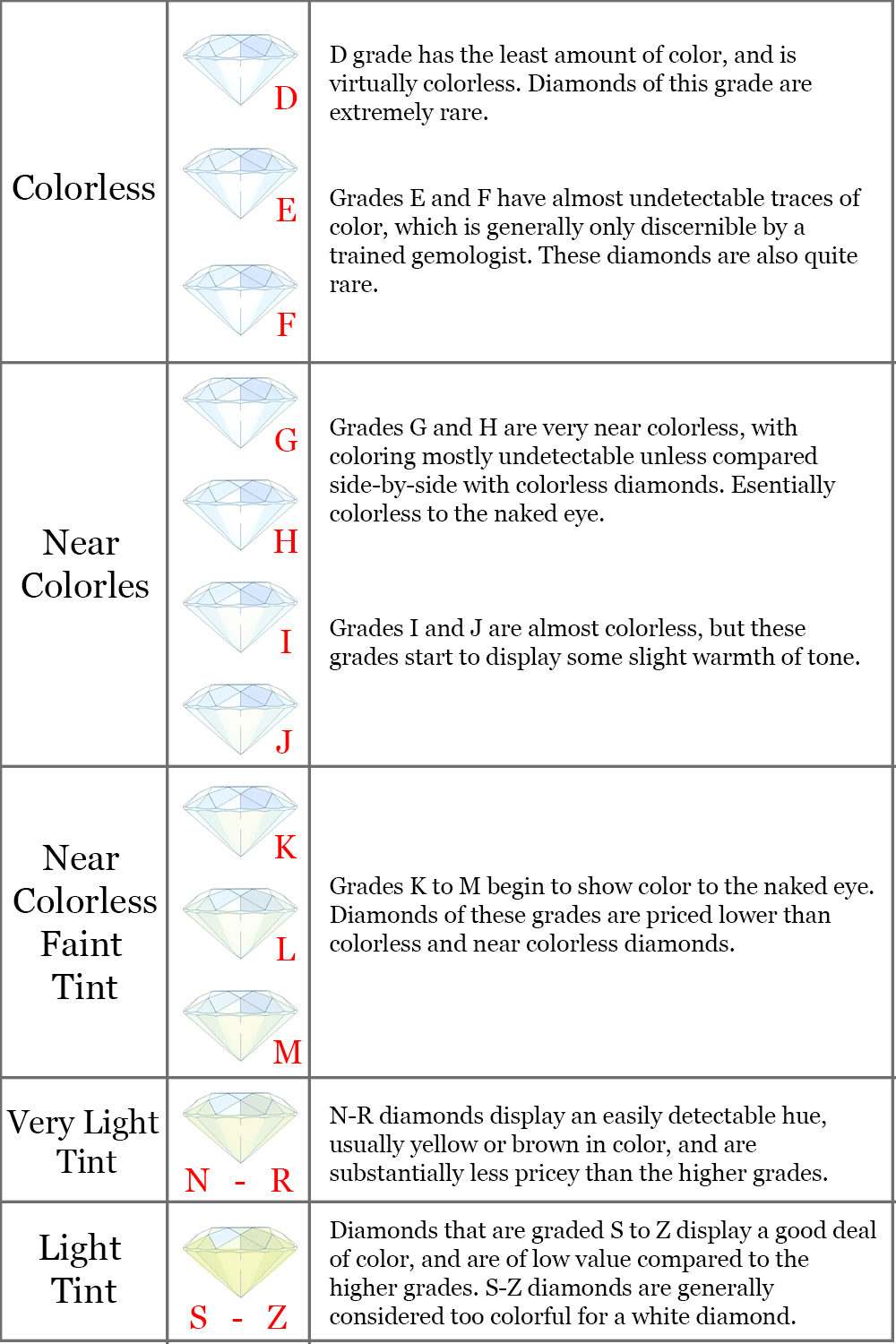Diamond Buying Guide – The 4 C’s Of Diamonds

Buying a loose diamond or a diamond ring can be an overwhelming experience for someone who isn’t familiar with the technical jargon. You are likely to come across diamond grading information that will seem confusing at first, but with a little knowledge you will know the difference between a VVS1 and SI1 diamond; the difference between a good cut and an excellent cut; what the color grading system means; and more. This knowledge will allow you to compare different diamonds, and will help you to choose the diamond that is right for you.
The 4 Cs of diamonds – Cut. Clarity. Color. Carat.
Cut, clarity, color, and carat weight are four of the most important qualities that you will come across when discussing a diamond with a jeweler, as well as when looking at a diamond grading report. This article focuses on these four qualities, and attempts to explain the various grading categories that belong to each. Many consider cut to be the most important of the four, as it affects the way that light moves within a diamond; this in turn affects a diamond’s brilliance, fire, and scintillation. So, we will begin with cut.
DIAMOND CUT
The word “cut” can refer to two different things in the diamond world. First, it can refer to the actual cutting of a stone, which affects the way that light interacts with it. Second, it can refer to the shape of a stone (for example: round, pear, marquise, etc.). As far as diamond quality and grading goes, we are interested in and will be discussing the first – the way that a stone is cut from a rough diamond.
The angles that a diamond is cut at, as well as its final polish, determine both surface reflection and internal reflection (the light bouncing off inner surfaces). This is very important to a diamond’s appearance, as it affects the stone’s:
- Brilliance – the amount of light that is returned to the viewer’s eye.
- Fire – the prism effect that scatters white light into colored light.
- Scintillation – the flashes or sparkles that occur on a diamonds surface as it moves under light.
A diamond that is cut too deeply or too shallowly will not produce the kind of qualities that are sought after in a well cut stone. The image below illustrates in a rough way how depth of cut affects the way that light (pictured as a red line) enters and exits a diamond.

We have listed the most common cut gradings below:
IDEAL (used as the highest grading by some gemology labs, i.e., AGS, GCAL, IGI, etc.)
Cut to superb standards. Ideal proportion, symmetry, angles, and polish. These stones return a lot of light, and are very bright. They display even patterning and contrast between bright and dark areas within the stone.
EXCELLENT (used as the highest grading by the GIA)
A very high quality cut that creates excellent light return and balance/contrast between light and dark areas.
VERY GOOD
A well cut diamond that displays a good amount of brightness and balance between the light and dark areas within a stone, only slightly less so than an Excellent cut.
GOOD
A cut that isn’t quite as bright as the higher gradings, with slightly less sharp reflections and more darkness/dullness in the stone.
FAIR AND POOR
Much more obvious dark or dull patches, sometimes combined with worse reflective properties.
These descriptions of cut grades should be used as a general guideline, and aside from Ideal cut, the above descriptions follow GIA’s grading standards. The cut that you choose should be decided by a combination of personal preference and price point. If you are after a diamond that has excellent brightness and an optimal balance of light and dark areas, it’s best to choose the highest cut grading available.
DIAMOND CLARITY
The clarity grade refers to the degree of flaws that exist within a diamond. These flaws present themselves in one of two ways: they appear as either inclusions, which are flaws present within a diamond, or they appear as blemishes, which are flaws that exist on the surface of a diamond.
- Inclusions are usually created during the lengthy diamond-forming process that occurs deep within the Earth’s crust. They are often caused by the formation of secondary mineral crystals within a diamond, or small flaws in a diamond’s structure.
- Blemishes are often caused during the cutting and polishing process, but can also occur naturally.
When a diamond is being graded for clarity, it is examined under 10x magnification. Keep this in mind when reading the clarity grades that are given below, as many flaws are not actually detectable by the naked eye.
Diamond Clarity Grades
Flawless (abbreviated as F)
These diamonds have no internal or external flaws. They are very rare, and cost substantially more than lower clarity graded diamonds. You will pay a high premium for this grade.
Internally Flawless (abbreviated as IF)
No internal flaws present, with the possibility of some very minor flaws on the surface. These stones are also quite rare and costly.
Very Very Slightly Included 1 and 2 (abbreviated as VVS1-VVS2)
These are diamonds that have tiny inclusions or blemishes that are difficult to detect, even by a trained professional. VVS1-VVS2 diamonds are more widely available than F and IF diamonds.
Very Slightly Included 1 and 2 (abbreviated as VS1-VS2)
The inclusions that exist in these diamonds can also be difficult to detect under 10x magnification, but are more apparent than VVS diamonds. VS diamonds are more common and are more widely available.
Slightly Included (abbreviated as SI1-SI2)
Small inclusions are visible when aided with 10x magnification. Diamonds that are graded as slightly included may present inclusions that are visible to the unaided eye (for more info see “A note on the number beside the grade” below).
Included 1, 2, and 3 (abbreviated as I1, I2, I3)
Diamonds that are graded as Included will have flaws that are visible to the unaided eye. We do not recommend this grade to anyone looking for an eye-clean diamond.
* Remember, clarity is graded by a gemologist who is viewing a diamond under 10x magnification. The grading descriptions above generally follow GIA standards. Other gemological labs may use the same grading names (IF, F, VVS1, etc.), but have different standards for each grade.

the above graphics are for reference and may not be an accurate representation of inclusion size or rate.
A note on the number beside the grade:
The number beside the grade represents the range within that grade. A lower number generally signifies less noticeable inclusions. This number is particularly important when buying SI graded diamonds. GIA (Gemological Institute of America) and AGS (American Gem Society) graded SI1 diamonds are usually eye-clean, which means that inclusions won’t be visible to the naked eye. However, SI2 inclusions are fairly likely to be visible to the naked eye, although some SI2 diamonds are eye-clean. If you are looking to own an SI graded diamond, we recommend that you stick to SI1, unless you are able to see the SI2 diamond up close and can confirm that the diamond is eye-clean, or you don’t mind the possibility of having a visible inclusion.
SI1 diamonds that are under 1 carat, that have been graded using GIA standards, are often considered the best bang for the buck regarding a diamond’s clarity. This is because most SI1 diamonds that are smaller than 1 carat look the same to the naked eye as Flawless graded diamonds, but are more common and less pricey than the higher clarity grades.
DIAMOND COLOR
When discussing diamond grading, color refers to the amount of tint in a white diamond. This coloring is the natural hue of the diamond, caused by its chemical or structural composition, and won’t fade over time. While fancy colored diamonds are prized, and generally available at a premium price, white diamonds are usually not completely white, and will have some degree of tint.
Tint in a white diamond is not considered desirable, and the color grading scale was developed to indicate the degree to which a particular diamond is tinted. The scale starts with the letter D, which represents a colorless or tint-less diamond, and continues through the alphabet with increasing tint until the last letter Z, which represents a lightly hued yellow or brown. The diamond color chart shown below is meant to give a general impression of the various color grades.

DIAMOND CARAT WEIGHT
Carat is the unit of measurement that is used to weigh diamonds, and is abbreviated as “ct”. One carat is equal to 1/5th of a gram (200 milligrams); the carat is then divided by 100, with each hundredth being referred to as a “point”. For example, if a jeweler were to tell you that a particular ring featured a 50 point diamond, that would mean that the diamond weighs one half of a carat.
So how is carat weight reflected in diamond price?
If you take two diamonds of the same quality, but one is twice as big as the other, you may expect the price difference to be about two times more for the diamond that is two times bigger. However, diamond pricing doesn’t work this way because larger stones are found in the earth less frequently than smaller stones, which means that they are more rare and therefore more valuable. So, all things being equal, a larger diamond will cost more per carat than a smaller diamond.
Price point jumps:
When looking to buy a diamond, it’s good to know that there are often price point jumps related to carat weight. Jumps usually occur in pricing at .50 ct, .70 ct, 1 ct, and every half carat after. This is particularly good to know if you are searching for a stone that won’t break your wallet, and are looking for the best bang for your buck. For instance, you are not likely to see much of a difference in terms of visual stone size when looking at a ring set with a .65 carat diamond, compared to a ring set with a .70 carat diamond. However, given that the two diamonds are of equal quality, you may see a jump in price for the .70 carat stone.
Buying larger diamonds:
When buying larger diamonds, small flaws or variance in color become more apparent. If it is important for you to buy a larger stone that is eye-clean, you may want to choose a higher clarity grading to get what you desire.
Fun fact:
The word “carat” is derived from the word “carob”, which is taken from the name of a Mediterranean tree. The carob tree produces an abundance of seeds that were at one time used as a standard unit of weight to measure against gold and gemstones. Carob seeds would be placed on one side of a balance scale, with the items to to be weighed on the other side. Seeds would be added until the scale balanced, and the seeds were then counted to determine the “carob” weight. The word “carob” eventually morphed into “carat”, which is still in use today!
CONCLUSION
We hope that the information in this article will help you to make an informed decision when buying a diamond. We know it is a lot to absorb in one go, so please re-read it if you need to – it’s important to understand the 4 Cs of diamonds before buying a diamond!
We do not sell unmounted diamonds, but if you are looking to purchase a ring from us, we will do our best to find and mount a diamond that fits your desired grading specifications. Feel free to contact us to discuss it.

